
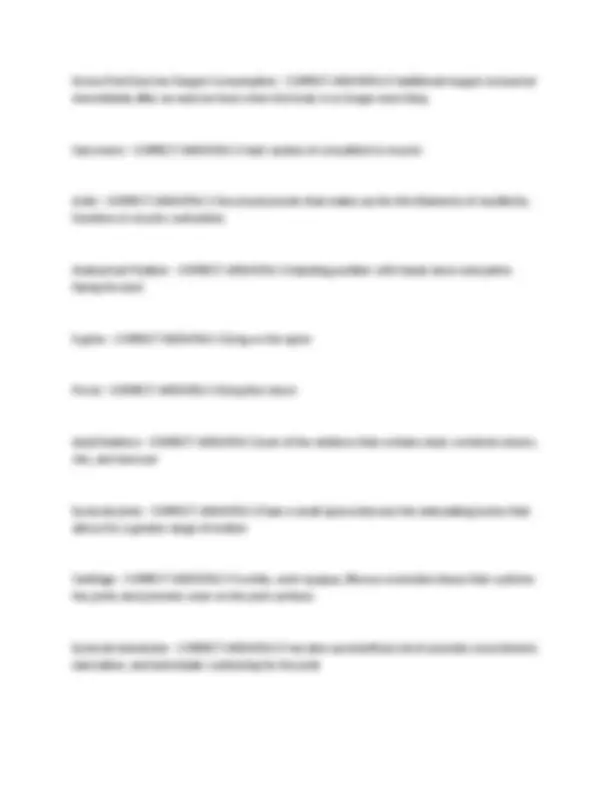
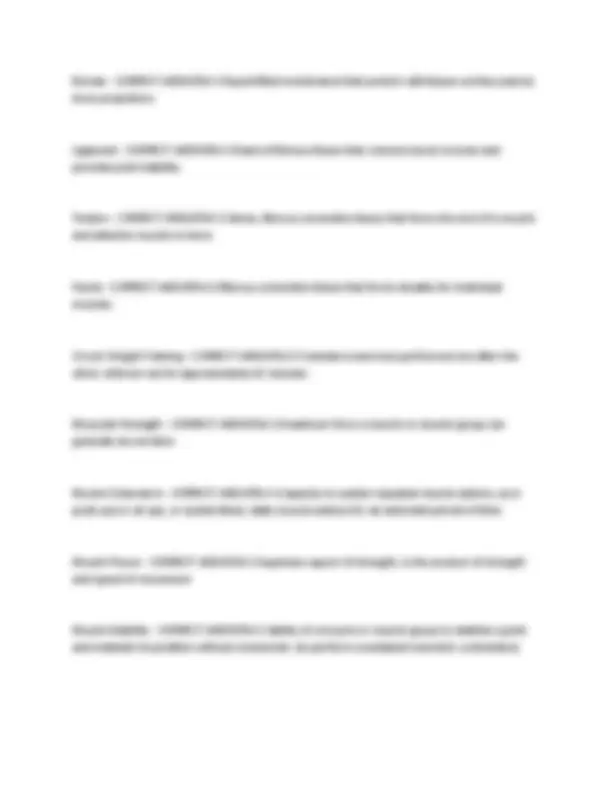
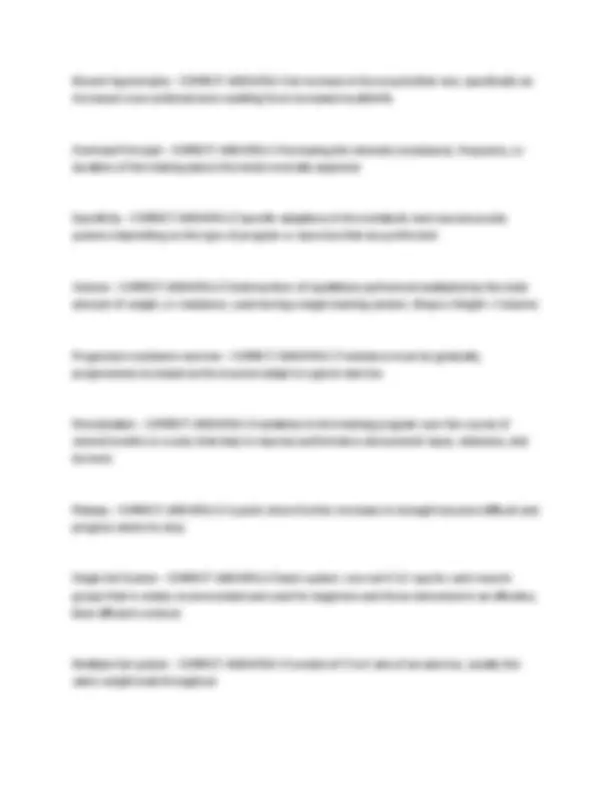
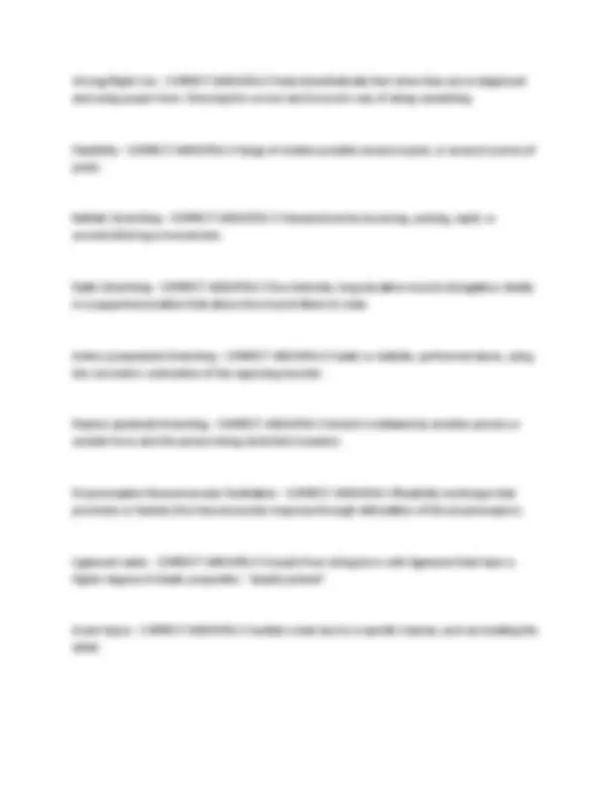
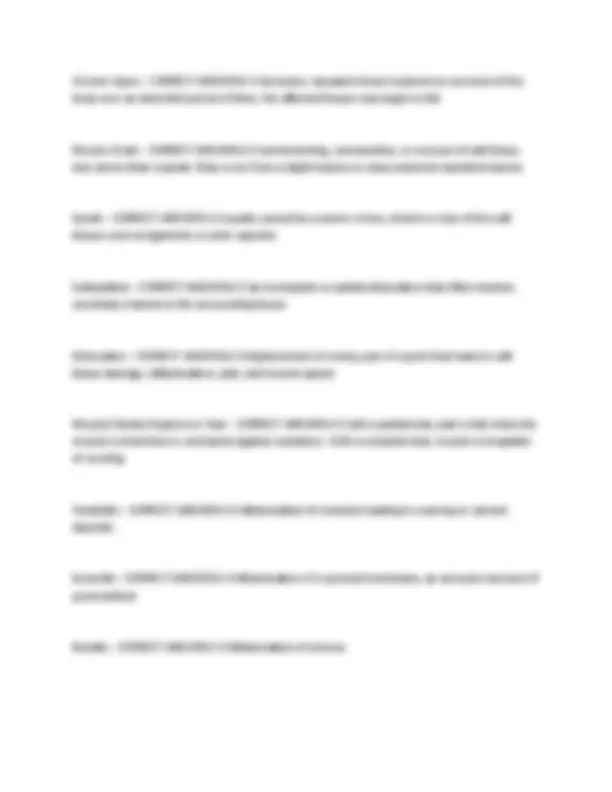
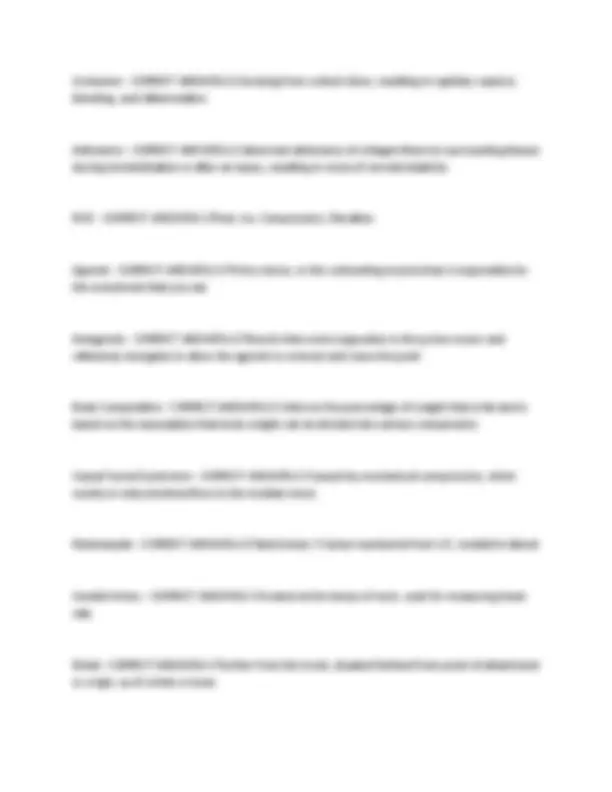
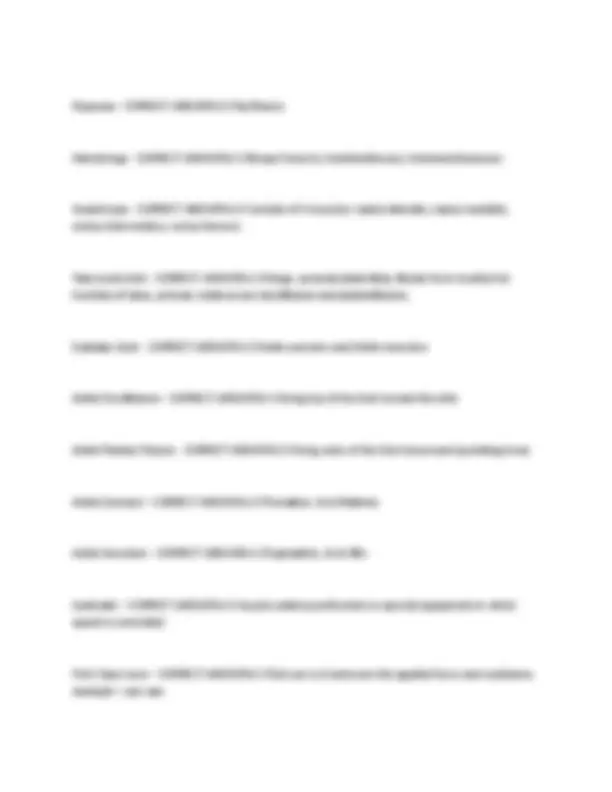
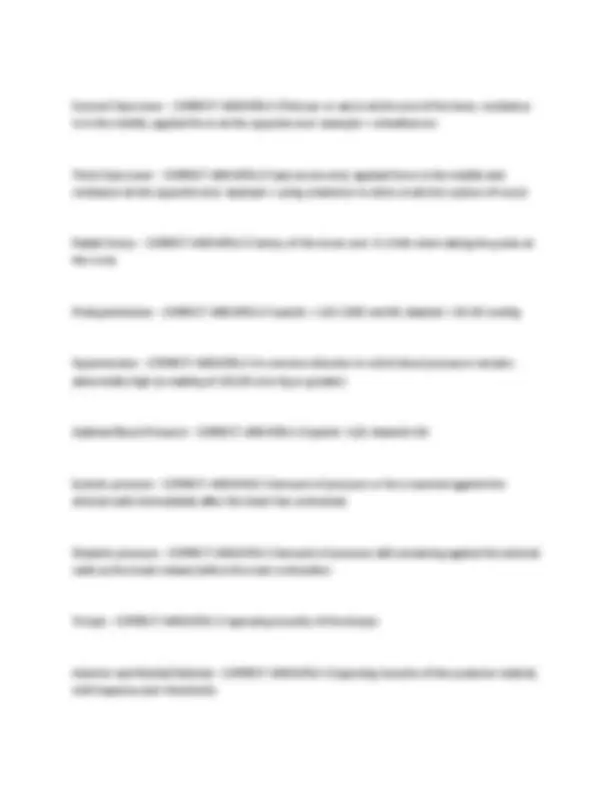
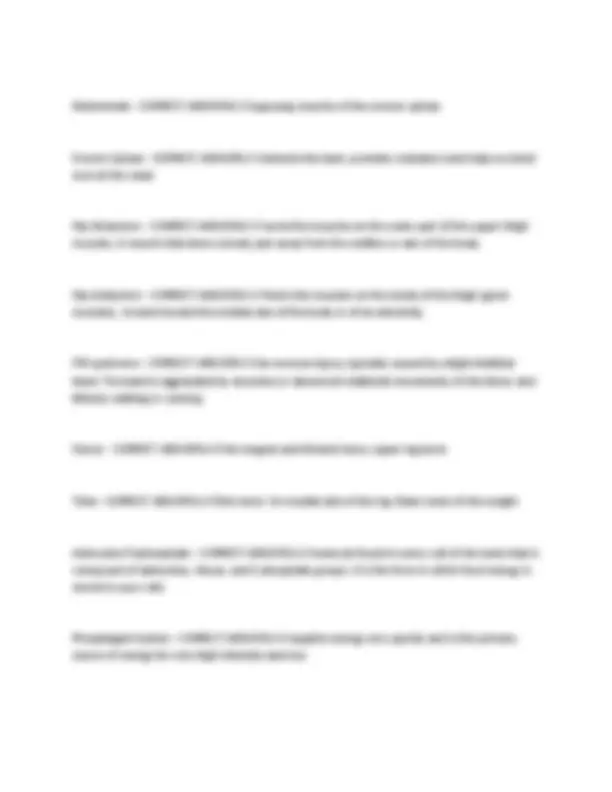
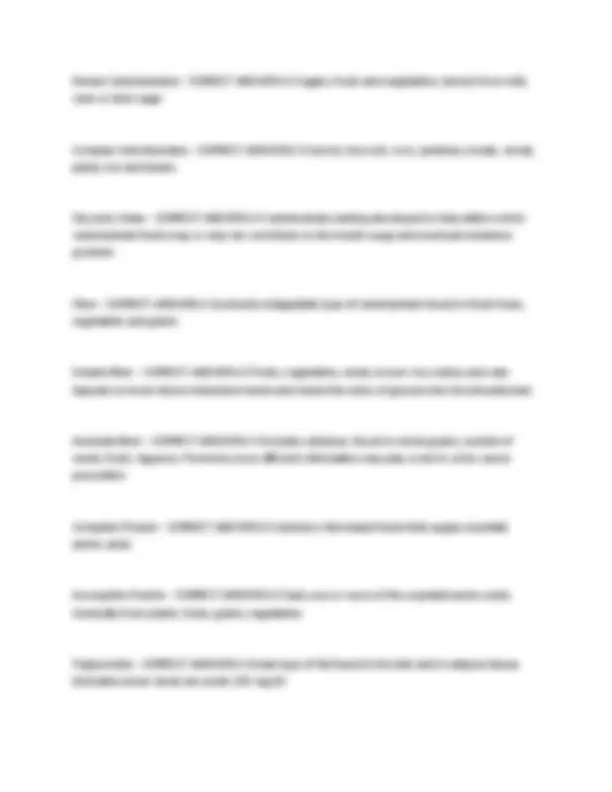
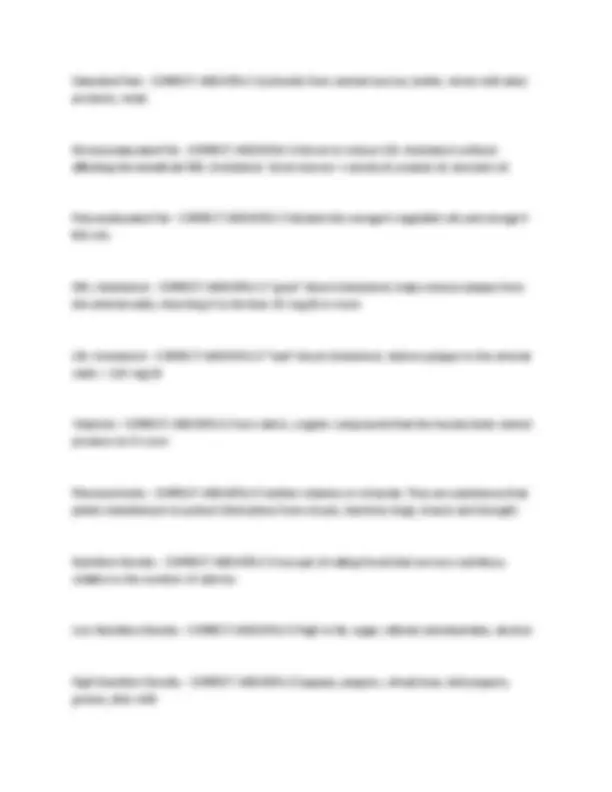
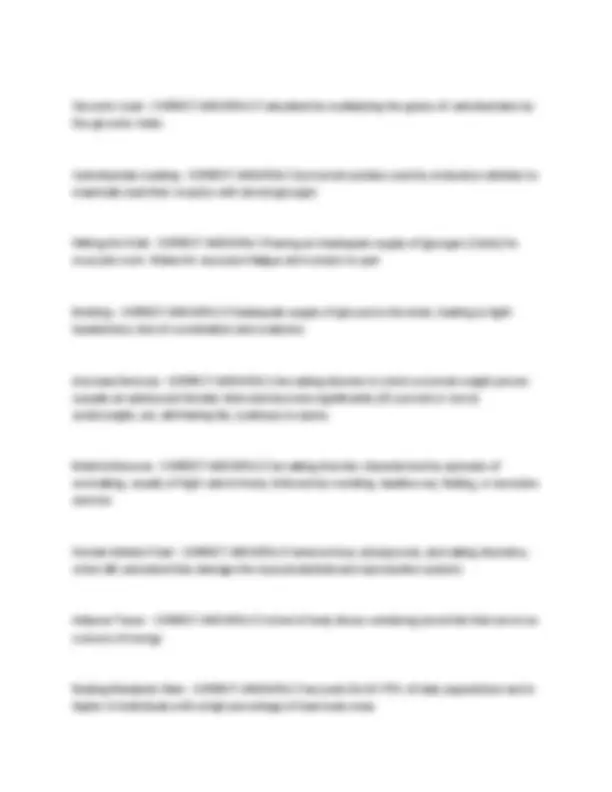
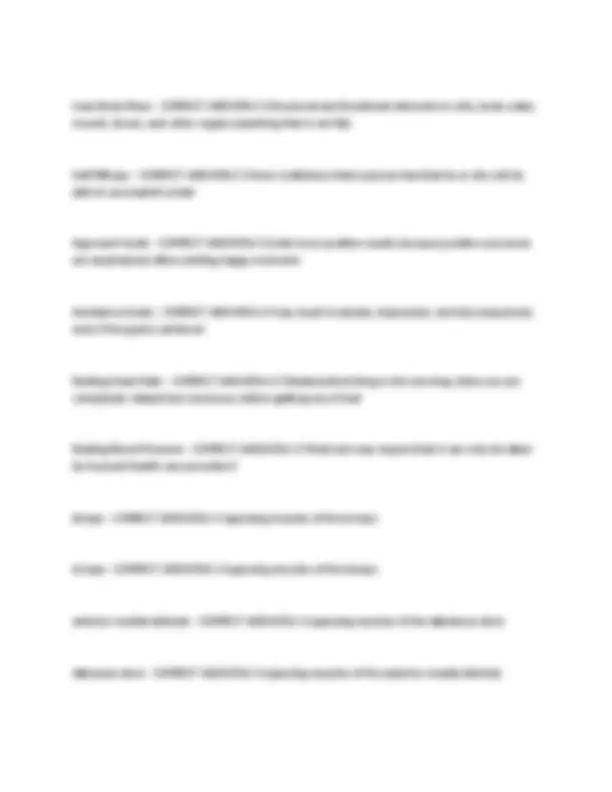
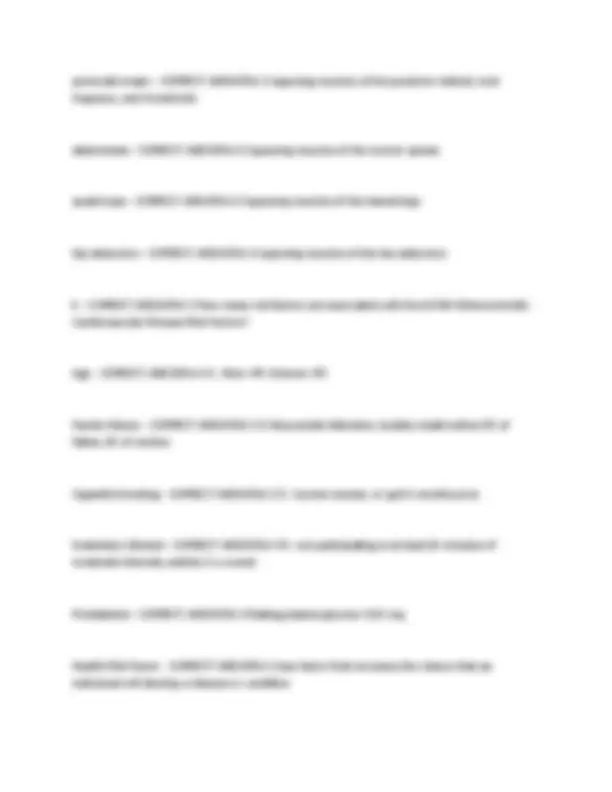
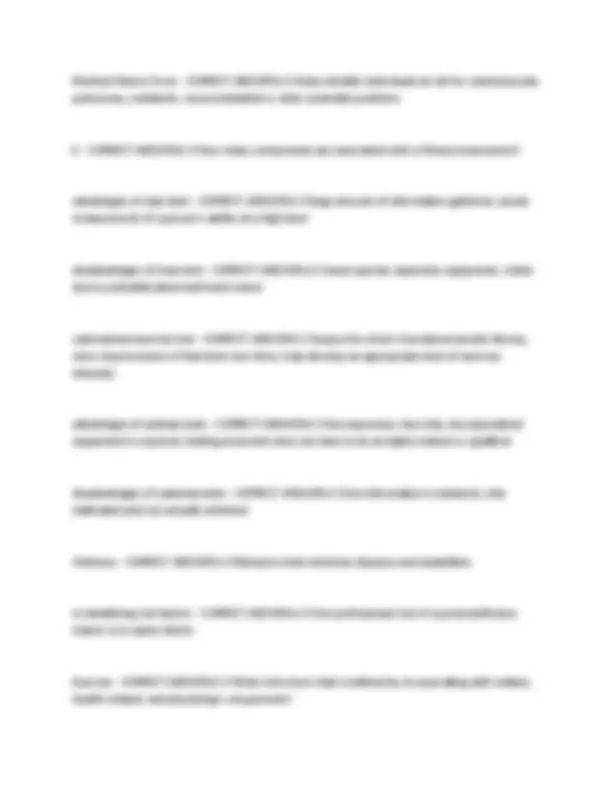
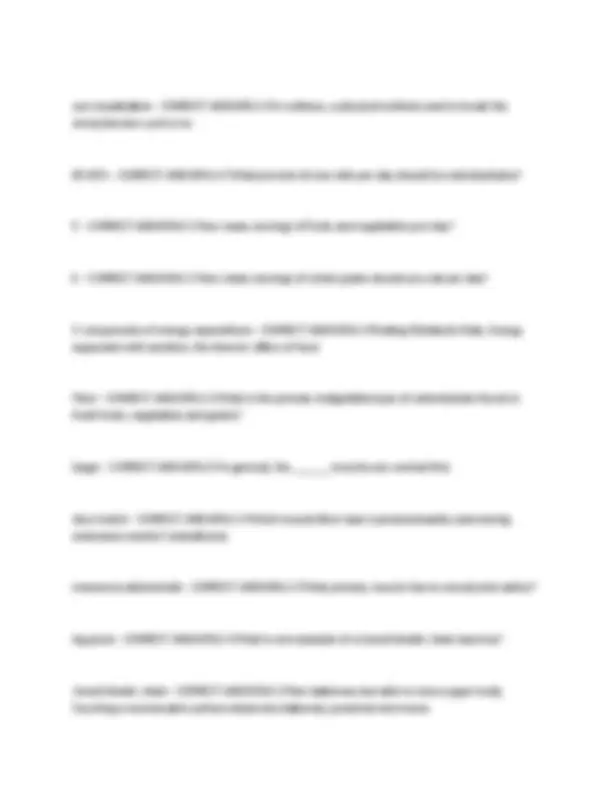
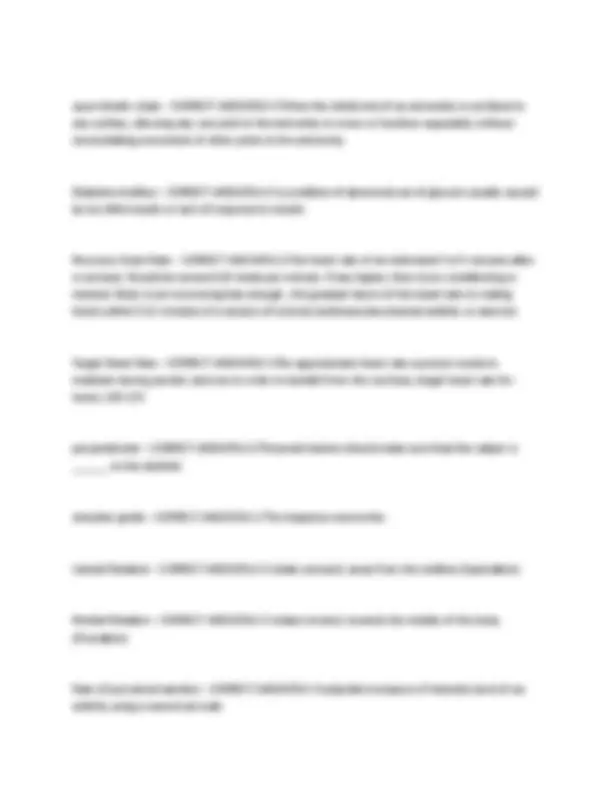
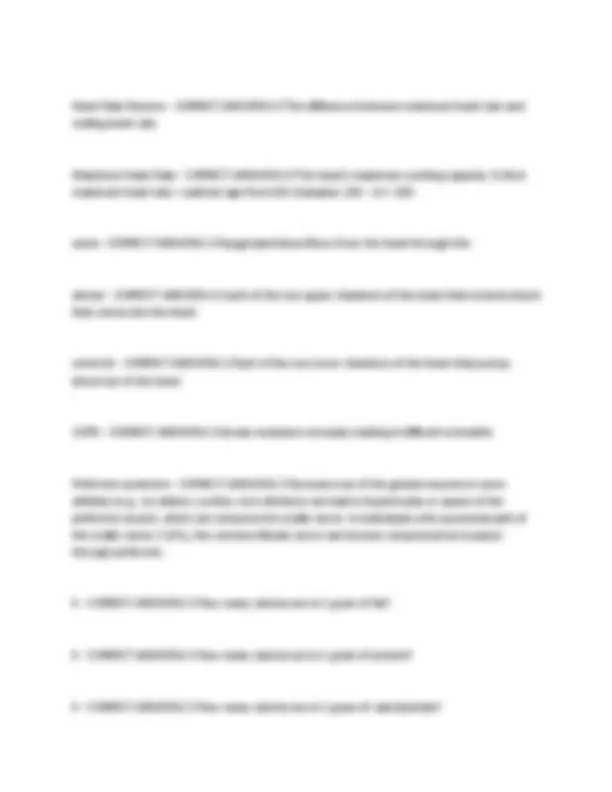
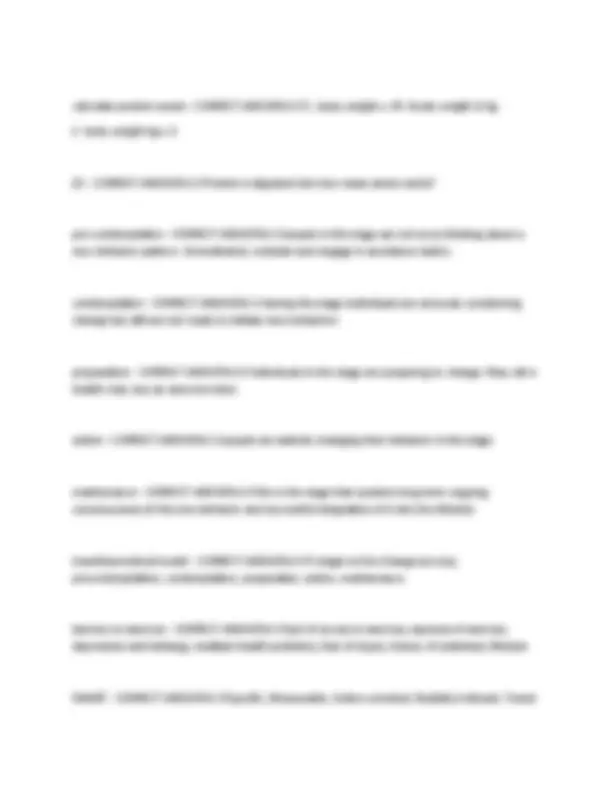
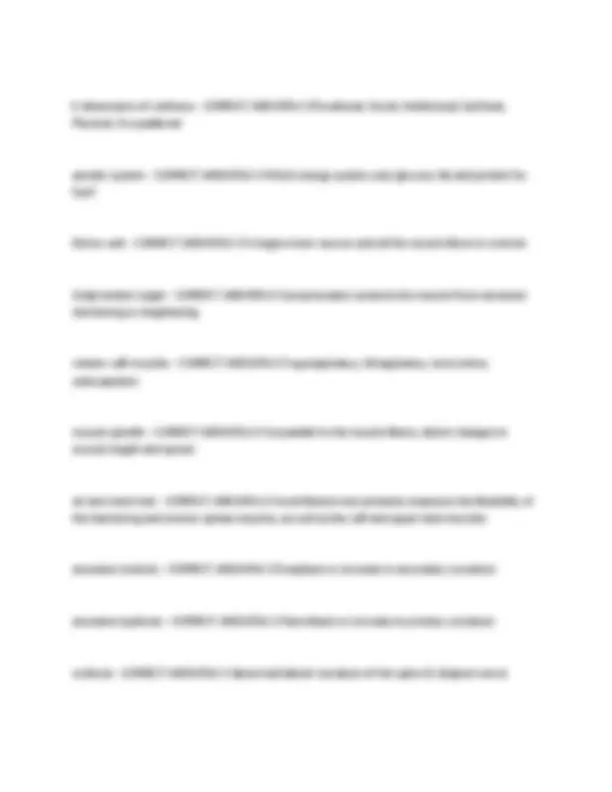
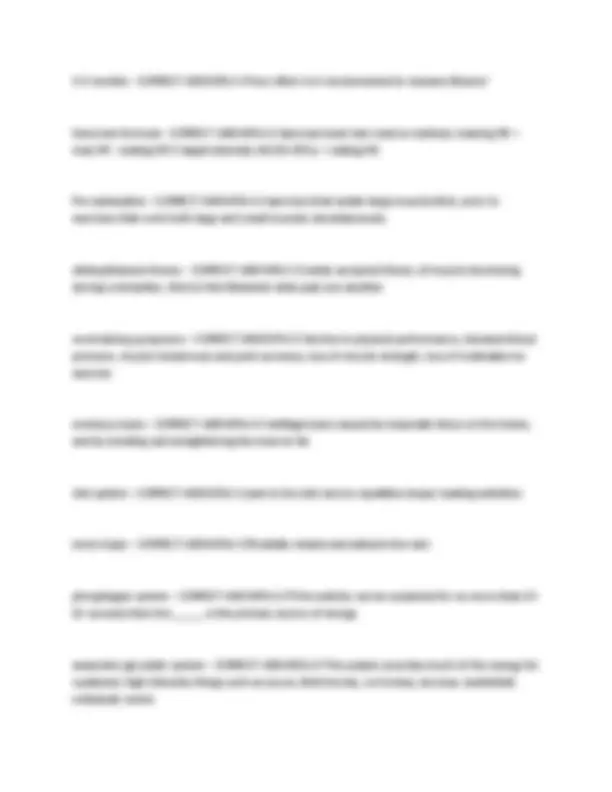
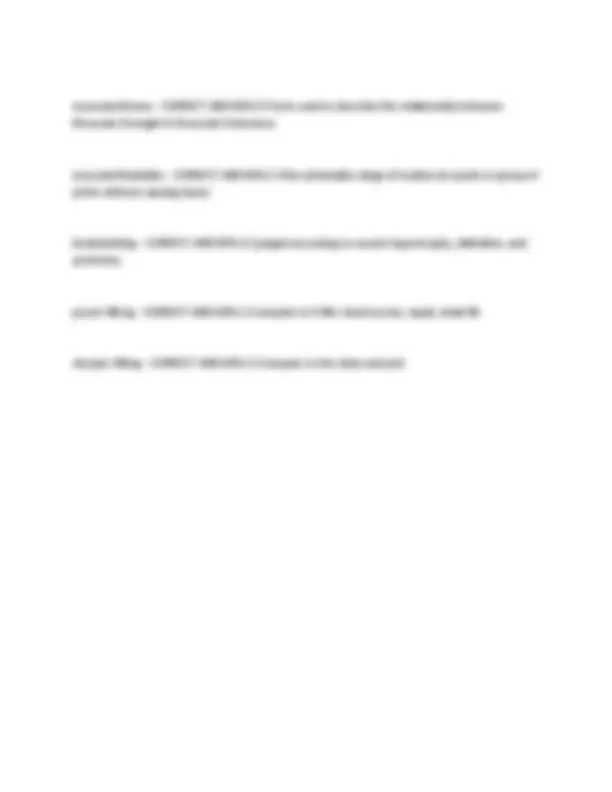


Study with the several resources on Docsity

Earn points by helping other students or get them with a premium plan


Prepare for your exams
Study with the several resources on Docsity

Earn points to download
Earn points by helping other students or get them with a premium plan
Community
Ask the community for help and clear up your study doubts
Discover the best universities in your country according to Docsity users
Free resources
Download our free guides on studying techniques, anxiety management strategies, and thesis advice from Docsity tutors
AFAA PERSONAL TRAINER CERTIFICATION EXAM 2025 WITH 100% ACCURATE SOLUTIONS
Typology: Exams
1 / 30

This page cannot be seen from the preview
Don't miss anything!























Myocardial Infarction - CORRECT ANSWER✔✔Hear attack occurs due to lack of blood flow through the coronary arteries to the heart muscle Ischemia - CORRECT ANSWER✔✔lack of blood flow Stroke Volume - CORRECT ANSWER✔✔the amount of blood pumped with each beat or systole Cardiac Output - CORRECT ANSWER✔✔heart rate x stroke volume. usually measured in liters (or milileters) of blood pumped per minute Venous Return - CORRECT ANSWER✔✔The amount of blood returned to the heart by the veins Valsalva Maneuver - CORRECT ANSWER✔✔occurs when a person holds his or her breath during a strenuous activity, such as lifting weights or shoveling snow Minute Ventilation - CORRECT ANSWER✔✔total amount of air breathed per minute Residual lung volume - CORRECT ANSWER✔✔amount of air remaining in the lungs after a complete and total forced exhale Forced vital capacity - CORRECT ANSWER✔✔amount of air that can be forcefully exhaled after a maximal inahle
Total lung capacity - CORRECT ANSWER✔✔sum of the residual volume and the forced vital capacity Glucose - CORRECT ANSWER✔✔body's usable form of carbohydrate Lactic Acid - CORRECT ANSWER✔✔produced in muscles during rapid exercise when the body cannot supply enough oxygen to the tissues Glycolysis - CORRECT ANSWER✔✔a metabolic process that breaks down carbohydrates and sugars through a series of reactions to either pyruvic acid or lactic acid and release energy for the body in the form of ATP Mitochondria - CORRECT ANSWER✔✔a subcellular structure where oxidation takes place Beta oxidation - CORRECT ANSWER✔✔A metabolic sequence that breaks fatty acids down to two-carbon fragments that enter the citric acid cycle as acetyl CoA. Krebs cycle - CORRECT ANSWER✔✔the acetyl CoA formed in the first component of aerobic metabolism enters into the citric acid cycle Electron transport system - CORRECT ANSWER✔✔the final sequence of reactions in the aerobic production of ATP Maximal oxygen uptake - CORRECT ANSWER✔✔the maximum amount of oxygen consumed and utilized by the body during an all-out effort to exhaustion
Bursae - CORRECT ANSWER✔✔liquid-filled membranes that protect soft tissues as they pass by bony projections Ligament - CORRECT ANSWER✔✔band of fibrous tissue that connects bone to bone and provides joint stability. Tendon - CORRECT ANSWER✔✔dense, fibrous connective tissue that forms the end of a muscle and attaches muscle to bone Fascia - CORRECT ANSWER✔✔fibrous connective tissue that forms sheaths for individual muscles. Circuit Weight Training - CORRECT ANSWER✔✔resistance exercises performed one after the other without rest for approximately 20 minutes Muscular Strength - CORRECT ANSWER✔✔maximum force a muscle or muscle group can generate at one time Muscle Endurance - CORRECT ANSWER✔✔capacity to sustain repeated muscle actions, as in push-ups or sit ups, or sustain fixed, static muscle actions for an extended period of time Muscle Power - CORRECT ANSWER✔✔explosive aspect of strength, is the product of strength and speed of movement Muscle Stability - CORRECT ANSWER✔✔ability of a muscle or muscle group to stabilize a joint and maintain its position without movement. (to perform a sustained isometric contraction)
Muscle hypertrophy - CORRECT ANSWER✔✔an increase in the muscle fiber size, specifically an increased cross-sectional area resulting from increased myofibrilis Overload Principle - CORRECT ANSWER✔✔increasing the intensity (resistance), frequency, or duration of the training above the levels normally expected Specificity - CORRECT ANSWER✔✔specific adaptions in the metabolic and neuromuscular systems depending on the type of program or exercises that are performed Volume - CORRECT ANSWER✔✔total number of repetitions performed multiplied by the total amount of weight, or resistance, used during a single training session. (Reps x Weight = Volume) Progressive resistance exercise - CORRECT ANSWER✔✔resistance must be gradually, progressively increased as the muscles adapt to a given exercise Periodization - CORRECT ANSWER✔✔variations in the training program over the course of several months or a year, that help to improve performance and prevent injury, staleness, and burnout Plateau - CORRECT ANSWER✔✔a point where further increases in strength become difficult and progress seems to stop Single-Set System - CORRECT ANSWER✔✔basic system ( one set 8-12 reps for each muscle group) that is widely recommended and used for beginners and those interested in an effective, time efficient workout Multiple-Set system - CORRECT ANSWER✔✔consists of 3 to 6 sets of an exercise, usually the same weight load throughout
Plyometric Training - CORRECT ANSWER✔✔involves using the stretch reflex to increase muscle fiber recruitment. (squat jumps, tuck jumps, medicine ball passes) Scapulae - CORRECT ANSWER✔✔shoulder blades Patella - CORRECT ANSWER✔✔kneecap Acute Muscle Soreness - CORRECT ANSWER✔✔occurs during and immediately after exercise and is due to the accumulation of lactate, decreased oxygen, and tissue swelling within the muscle Delayed Onset Muscle Soreness (DOMS) - CORRECT ANSWER✔✔A temporary muscle soreness and stiffness that occur 24 to 48 hours after performing unaccustomed eccentric muscle contractions and last for three to four days. Alignment Cue - CORRECT ANSWER✔✔clearly state which joints are moving and which are still Safety Cue - CORRECT ANSWER✔✔lets client know about a potential injury risk and how it can be minimized Breathing Cue - CORRECT ANSWER✔✔remind your clients to breathe Visual Cue - CORRECT ANSWER✔✔demonstrating a move Motivational Cue - CORRECT ANSWER✔✔motivational cues such as "You can do it!" and "Great Job!"
Wrong/Right Cue - CORRECT ANSWER✔✔help kinesthetically feel when they are in alignment and using proper form. Showing the correct and incorrect way of doing something. Flexibility - CORRECT ANSWER✔✔range of motion possible around a joint, or around a series of joints Ballistic Stretching - CORRECT ANSWER✔✔characterized by bouncing, pulsing, rapid, or uncontrolled-type movements Static Stretching - CORRECT ANSWER✔✔low-intensity, long-duration muscle elongation; ideally in a supported position that allows the muscle fibers to relax Active (unassisted) Stretching - CORRECT ANSWER✔✔static or ballistic, performed alone, using the concentric contraction of the opposing muscles Passive (assisted) Stretching - CORRECT ANSWER✔✔stretch is initiated by another person or outside force and the person being stretched is passive Proprioceptive Neuromuscular Facilitation - CORRECT ANSWER✔✔flexibility technique that promotes or hastens the neuromuscular response through stimulation of the proprioceptors Ligament Laxity - CORRECT ANSWER✔✔results from being born with ligaments that have a higher degree of elastic properties. "double jointed" Acute Injury - CORRECT ANSWER✔✔sudden onset due to a specific trauma, such as twisting the ankle
Contusion - CORRECT ANSWER✔✔bruising from a direct blow, resulting in capillary rupture, bleeding, and inflammation Adhesions - CORRECT ANSWER✔✔abnormal adherance of collagen fibers to surrounding tissues during immobilization or after an injury, resulting in a loss of normal elasticity RICE - CORRECT ANSWER✔✔Rest, Ice, Compression, Elevation Agonist - CORRECT ANSWER✔✔Prime mover, or the contracting muscle that is responsible for the movement that you see Antagonist - CORRECT ANSWER✔✔Muscle that works (opposite) to the prime mover and reflexively elongates to allow the agonist to contract and move the joint Body Composition - CORRECT ANSWER✔✔refers to the percentage of weight that is fat and is based on the assumption that body weight can be divided into various components Carpal Tunnel Syndrome - CORRECT ANSWER✔✔caused by mechanical compression, which results in reduced blood flow to the median nerve Metacarpals - CORRECT ANSWER✔✔Hand bones. 5 bones numbered from 1-5, medial to lateral Carotid Artery - CORRECT ANSWER✔✔located at the larnyx of neck, used for measuring heart rate Distal - CORRECT ANSWER✔✔further from the trunk, situated farthest from point of attachment or origin, as of a limb or bone
Eccentric Training - CORRECT ANSWER✔✔Also called negative resistance training, is a muscular action in which the muscle lengthens in a controlled manner. Concentric Training - CORRECT ANSWER✔✔exerting more force than is placed on it, results in shortening of muscle Glenohumeral - CORRECT ANSWER✔✔shoulder - structure: synovial; ball and socket function:diarthrotic ROM:multiaxial flexion, extension, abduction, adduction, circumduction, rotation Slow Twitch Fibers - CORRECT ANSWER✔✔slow to fatigue and have a high level of aerobic endurance, used for long-term, low to moderate intensity activities ranging from maintaining proper posture to long-distance running Fast Twitch Fibers - CORRECT ANSWER✔✔poor aerobic endurance, short-duration, high-intense activities and fatigue quickly Proprioceptors - CORRECT ANSWER✔✔sense the degree of tension and the length of the muscle Flexion - CORRECT ANSWER✔✔joint angle diminishing, most movements are forward movements Extension - CORRECT ANSWER✔✔return from flexion, movement that increases the angle between 2 bones Rotation - CORRECT ANSWER✔✔movement around an axis or pivot point
Iliopsoas - CORRECT ANSWER✔✔hip flexors Hamstrings - CORRECT ANSWER✔✔Biceps Femoris, Semitendinosus, Semimembranosus Quadriceps - CORRECT ANSWER✔✔consists of 4 muscles: vastus lateralis, vastus medialis, vestus intermedius, rectus femoris Talocrural Joint - CORRECT ANSWER✔✔hinge, synovial,distal tibia, fibular form mortise for trochlea of talus, primary motions are dorsiflexion and plantarflexion, Subtalar Joint - CORRECT ANSWER✔✔Ankle eversion and Ankle inversion Ankle Dorsiflexion - CORRECT ANSWER✔✔bring top of the foot toward the shin Ankle Plantar Flexion - CORRECT ANSWER✔✔bring soles of the foot downward (pointing toes) Ankle Eversion - CORRECT ANSWER✔✔Pronation. Arch flattens Ankle Inversion - CORRECT ANSWER✔✔Supination, Arch lifts Isokinetic - CORRECT ANSWER✔✔muscle actions performed on special equipment in which speed is controlled First Class Lever - CORRECT ANSWER✔✔fulcrum is in between the applied force and resistance. example = see-saw
Second Class Lever - CORRECT ANSWER✔✔fulcrum or axis is at the end of the lever, resistance is in the middle, applied force at the opposite end. example = wheelbarrow Third Class Lever - CORRECT ANSWER✔✔axis as one end, applied force in the middle and resistance at the opposite end. example = using a hammer to drive a nail into a piece of wood Radial Artery - CORRECT ANSWER✔✔artery of the lower arm. It is felt when taking the pulse at the wrist. Prehypertension - CORRECT ANSWER✔✔systolic = 120-1389 mmHG diastolic = 80-89 mmHg Hypertension - CORRECT ANSWER✔✔a common disorder in which blood pressure remains abnormally high (a reading of 140/90 mm Hg or greater) Optimal Blood Pressure - CORRECT ANSWER✔✔systolic <120 diastolic< Systolic pressure - CORRECT ANSWER✔✔amount of pressure or force exerted against the arterial walls immediately after the heart has contracted Diastolic pressure - CORRECT ANSWER✔✔amount of pressure still remaining against the arterial walls as the heart relaxes before the next contraction Triceps - CORRECT ANSWER✔✔opposing muscles of the biceps Anterior and Medial Deltoids - CORRECT ANSWER✔✔opposing muscles of the posterior deltoid, mid-trapezius and rhomboids
Anaerobic Glycolytic System - CORRECT ANSWER✔✔Glucose is used for fuel and is either blood glucose or muscle glycogen, broken down in to pyruvic acid, when there is insufficient oxygen it then is transformed into lactic acid Aerobic Energy System - CORRECT ANSWER✔✔virtually unlimited capacity for making ATP, uses carbs, fat, protein for fuel. Slow to produce ATP Anaerobic Threshold - CORRECT ANSWER✔✔when work becomes so intense, muscle cells cannot supply the additional energy and rely more on the anaerobic system to produce ATP. At this level, lactic acid begins to accumulate Skeletal Muscle - CORRECT ANSWER✔✔A muscle that is attached to the bones of the skeleton and provides the force that moves the bones. Smooth Muscle - CORRECT ANSWER✔✔a muscle that contracts without conscious control and found in walls of internal organs such as stomach and intestine and bladder and blood vessels (excluding the heart) Cardiac Muscle - CORRECT ANSWER✔✔forms the walls of the heart Sensory Neurons - CORRECT ANSWER✔✔bring messages back to the brain and spinal cord from the muscles, skin and other areas of the body Motor Neurons - CORRECT ANSWER✔✔send messages from the brain and spinal cord to the muscles causing a neuromuscular response Appendicular Skeleton - CORRECT ANSWER✔✔forms the extremities and is composed of the shoulder girdle, arm bones, pelvic girdle, and leg bones, , the portion of the skeleton that attaches to the axial skeleton and has the limbs attached to it
Supination - CORRECT ANSWER✔✔hands upward Pronation - CORRECT ANSWER✔✔hands downward Tennis Elbow - CORRECT ANSWER✔✔painful inflammation of the tendon at the outer border of the elbow resulting from overuse of lower arm muscles (as in twisting of the hand) Golfer's Elbow - CORRECT ANSWER✔✔Inflammation and pain of the flexor and pronator muscles of the forearm where their tendons originate on the medial epicondyle of the humerus; Epicondylitis Rheumatoid Arthritis - CORRECT ANSWER✔✔a chronic autoimmune disease with inflammation of the joints and marked deformities Fibromyalgia - CORRECT ANSWER✔✔widespread pain in joints, muscles, ligaments, heightened pain at "Tender" points Osteopenia - CORRECT ANSWER✔✔premature bone thining, with a bone density of 1-2. standard deviation units below average Preipheral Artery Disease - CORRECT ANSWER✔✔condition of atherosclerosis in the extremities, primarly affecting the calves. Parkinson's Disease - CORRECT ANSWER✔✔disorder of the nervous system, specifically of the basal ganglia, a mass nerve of cells in the brain that is responsible for motor functions
Saturated Fats - CORRECT ANSWER✔✔primarily from animal sources, butter, whole milk dairy products, meat. Monounsaturated Fat - CORRECT ANSWER✔✔shown to reduce LDL cholesterol without affecting the beneficial HDL cholesterol. Good sources = canola oil, peanut oil, avocado oil Polyunsaturated Fat - CORRECT ANSWER✔✔divided into omega-6 vegetable oils and omega- 3 fish oils. HDL cholesterol - CORRECT ANSWER✔✔"good" blood cholesterol, helps remove plaque from the arterial walls, returning it to the liver. 60 mg/dl or more LDL cholesterol - CORRECT ANSWER✔✔"bad" blood cholesterol, delivers plaque to the arterial walls. < 100 mg/dl Vitamins - CORRECT ANSWER✔✔non-caloric, organic compounds that the human body cannot produce on it's own Phytonutrients - CORRECT ANSWER✔✔neither vitamins or minerals. They are substances that plants manufacture to protect themselves from viruses, bacteria, fungi, insects and drought. Nutrition Density - CORRECT ANSWER✔✔concept of eating foods that are very nutritious relative to the number of calories Low Nutrition Density - CORRECT ANSWER✔✔high in fat, sugar, refined carbohydrates, alcohol High Nutrition Density - CORRECT ANSWER✔✔papaya, peppers, wheat bran, bell peppers, greens, skim milk
Glycemic Load - CORRECT ANSWER✔✔calculated by multiplying the grams of carbohydrates by the glycemic index Carbohydrate Loading - CORRECT ANSWER✔✔pre-event practice used by endurance athletes to maximally load their muscles with stored glycogen Hitting the Wall - CORRECT ANSWER✔✔having an inadequate supply of glycogen (Carbs) for muscular work. Makes for excessive fatigue and a desire to quit Bonking - CORRECT ANSWER✔✔inadequate supply of glucose to the brain, leading to light- headedness, lack of coordination and weakness Anorexia Nervosa - CORRECT ANSWER✔✔an eating disorder in which a normal-weight person (usually an adolescent female) diets and becomes significantly (15 percent or more) underweight, yet, still feeling fat, continues to starve. Bulimia Nervosa - CORRECT ANSWER✔✔an eating disorder characterized by episodes of overeating, usually of high-calorie foods, followed by vomiting, laxative use, fasting, or excessive exercise Female Athlete Triad - CORRECT ANSWER✔✔amenorrhea, osteoporosis, and eating disorders; when left untreated they damage the musculoskeletal and reproductive systems Adipose Tissue - CORRECT ANSWER✔✔a kind of body tissue containing stored fat that serves as a source of energy Resting Metabolic Rate - CORRECT ANSWER✔✔accounts for 60-75% of daily expenditure and is higher in individuals with a high percentage of lean body mass